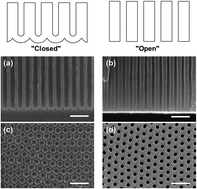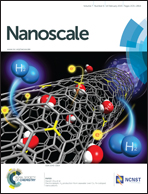Adsorption in alumina pores open at one and at both ends†
Abstract
We have studied adsorption in regular, self-ordered alumina pores open at both ends or only at one end. The straight, non-connected pores have diameters ranging from 22 to 83 nm, with a relative dispersion below 1% in the pore size. Adsorption isotherms measured in open pores with a torsional microbalance show pronounced hysteresis loops characterized by nearly vertical and parallel adsorption and desorption branches. Blocking one end of the pores with glue has a strong influence on adsorption, as expected from classical macroscopic arguments. However, the experimental measurements show an unexpectedly rich phenomenology dependent on the pore size. For large pores (Dp ≥ 67 nm), the isotherms for closed end pores present much narrower hysteresis loops whose adsorption and desorption boundaries envelop the desorption branches of the isotherms for the corresponding open pores of the same size. The loop for small closed end pores (Dp = 22 nm) is slightly wider than that for open pores while the adsorption branches coincide. For large pores, in contrast, the desorption branches of pores with the same Dp overlap regardless of the pore opening. These observations are in agreement with our grand canonical Monte Carlo (GCMC) simulations for a cylindrical pore model with constrictions, suggesting that the alumina pores could be modeled using a constricted pore model whose adsorption isotherm depends on the ratio of the constriction size to the pore size (Dc/Dp).


 Please wait while we load your content...
Please wait while we load your content...